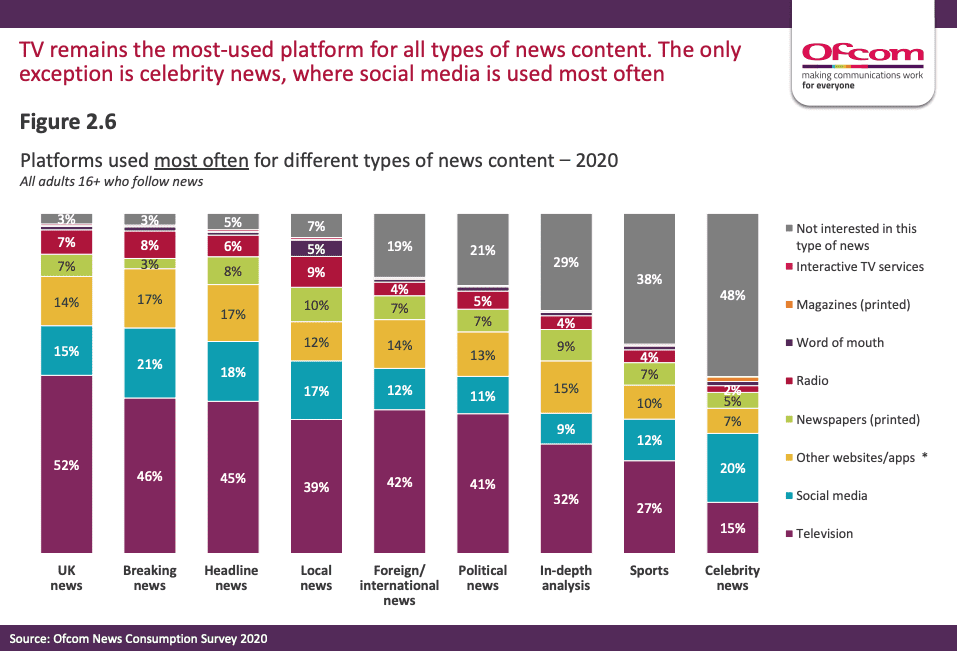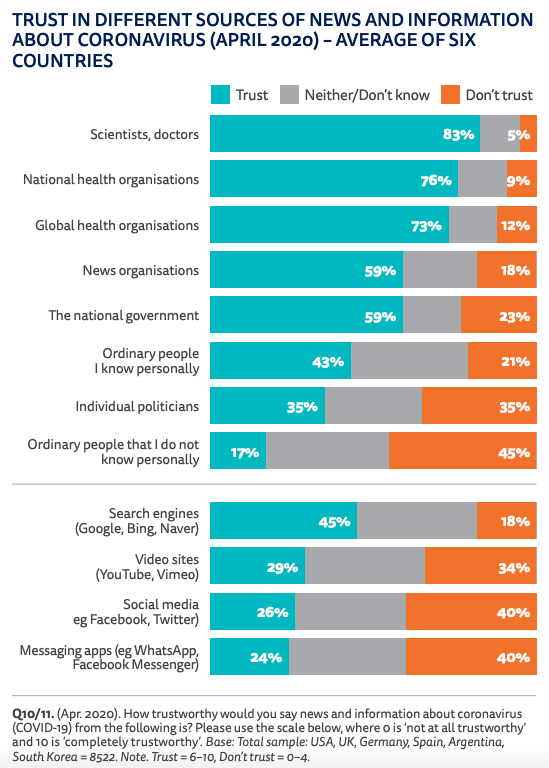I’ve worked in the PR industry for over eight years now and in that time it’s changed A LOT, and even more so during the pandemic.
New digital techniques, an increased shift to social and click-bait, and the changing needs of news outlets and journalists have really transformed the discipline.
So, if you’re an experienced comms professional terrified that everything you’ve learnt so far in your career is becoming irrelevant – do not panic. Or if you’re just starting out in your PR career, worried you’ve flushed nine grand-a-year down the toilet with your ‘traditional’ PR modules, you absolutely haven’t. Traditional and digital PR are not mutually exclusive. Instead, both have their roles to play – they simply have different objectives.
And so, while media consumption continues to evolve, traditional news rooms keep shrinking and media outlets pull their print editions, where does this leave ‘traditional’ PR? Here’s five reasons why its going nowhere…
1. Traditional media is still a powerful channel to reach your audience
The traditional media is still one of the most credible news sources and word of mouth remains a powerful tool for spreading a message.
Let’s take the largest pandemic of our lifetimes as an example of that. According to Ofcom, traditional media remained the most-used source of news and information about the coronavirus, used by almost nine in ten people (86%) and of these people, 63% said it was their most important news source.
Additionally, the most common way people shared news or information about coronavirus was by talking to family, friends or colleagues, either in person or over the phone.
With the rise of misinformation and fake news in our online world; radio, television, and news outlets will always be identifiable as a credible source of information to anyone at any age, and something that shouldn’t be discarded.
2. ‘We can’t measure PR!’ – Yes you can
There’s simply no skirting around the fact that measuring traditional PR has always been ambiguous and our old friend AVE (Advertising Value Equivalent) just isn’t a credible measurement tool. Was it ever?
Digital PR is much easier to quantify and you can prove its value in terms of website traffic, backlinks, performance on organic search and ROI for a business (like sales or enquiries).
Genuine brand awareness should continue to be a metric that’s held in high regard, particularly in a world where consumers buy into a brand’s values as much as the products or services it sells. That’s why it’s so important that you set out clear aims and objectives for your campaign or PR retainer from the outset so you can measure and quantify success.
Great PR isn’t about what you say about yourself, it’s what others say about you. And even better PR encourages a behaviour change. And there are so many ways to measure that too. We follow the best-practice guidelines laid out by AMEC’s Integrated Evaluation Framework, which means we’re focused on measuring:
- Outputs:
Media reach, impressions, sentiment, event attendance, clickthroughs, tweets
- Outtakes:
Subscribers, unique vistors, enquiries, comments, return visits, social followers and shares
- Outcomes:
Trust level, statements of support, brand preference, sign-ups, leads, registrations
- Impact:
Public support, sales increase, retention, donations, cost savings, targets met
Depending on your objectives, PR agencies like us will be able to make suggestions on the route we take to achieve that – whether that’s a paid media campaign to boost clicks or sign ups to a landing page or a traditional PR outreach plan with a well thought out story – or a concoction of both (which we love!).
Either way, one of the first questions from us will always be: ‘what does success look like for you?’.
3. Traditional media is trusted
Behind the smart branding, CSR strategies and witty social channels, brands are still headed up by actual real life human beings. And so, trust plays a key role. In a world where a brand’s purpose matters to people – and it is proven to influence their buying behaviours – you could argue trust is more important than ever.
Just like meeting your partner’s Mum for the first time, traditional media has had a much longer relationship with its audience (in this case, your partner!) and that established bond and connection makes it more difficult to swoop in on.
In the age of fake news and mis-information, people still tend to trust highly reputable, long-standing media outlets and news organisations over information from social and messaging apps.
Even as a millennial, when a viral news story breaks, I’ll always head to the BBC for the verified low-down but then straight onto Twitter for all the quick-witted memes and public reactions. So too do many others.
And that’s exactly why the traditional and digital worlds still complement each other.
4. The evolution of the press release to integrated comms
In Ye Olde days, press releases were the main and only form of communication between PR and journo – usually issued by post, fax or carrier pigeon (ask our MD, Gary about that one!).
While press releases still carry their weight when it comes to communication, we’ve also acknowledged that not everyone consumes information in the same way. This is why as PRs in a digital world, we go that step further in considering other tactics and channels to present the same information.
A blog with target search queries from your SEO agency; a guest-appearance on a relevant podcast; visual content with an animated video; a CEO interview or a social media launch with a sponsored hashtag and a list of pre-briefed target journalists are all examples of going that extra mile when considering how you can communicate with your audience and understanding the channels that work best.
It’s about thinking beyond a single tactic. It’s about thinking in an integrated way.
All of this, however, still relies on the traditional PR skill of storytelling.
While the channels and tools might have changed, the required expertise to pull it off are still completely relevant.
5. Digital has made us more human than ever
The coronavirus pandemic and the shift to working from home has meant that journalists have been even more difficult to get hold of, so PRs have had to work even harder to capture their attention.
As I mentioned earlier, we’re all human beings with lives outside of work. Many of us enjoy a Saturday night takeaway, a drink in a beer garden (finally!), and we all face our own personal challenges.
But digital channels and social media have given us more access to people’s lives than ever before. Through Instagram, I still follow the lives of girls I’ve met on holidays years ago, and people from my Uni courses that I did one group project with, and I’m sure I wouldn’t be the only one to admit that either. But naturally as human beings, we’re all just quite nosey! So how as PRs, do we use that to our advantage?
With more and more news outlets canning their print editions and focusing on digital subscriptions, there’s much more focus on website visits, clicks and engagement. After all, these outlets are still businesses, and these figures can be a highly attractive leverage for advertising and advertorial teams.
So, what inspires these clicks and comments? You guessed it – people. Real-life, relatable people with a story to tell.
Instead of leading with the brand’s story, what about the story behind how the brand’s Financial Director battles with dyslexia and still manages to head up a team of analysts? Or how your company’s pillow, while marketed to athletes and sportspeople, is helping hospitals tackle the coronavirus pandemic, or how an entrepreneur used your business to launch his own?
PR – whether traditional or digital – is rooted in storytelling but that knowledge to create those stories comes from a trained eye for one. And that’s a skill not to be sniffed at.
A good knowledge of the news landscape, a keen eye for a story and the skill of conveying a message is the foundation for a strong PR campaign – whether that’s digital or traditional.
As we face ever-changing technologies, new tools and approaches, PR agencies and professionals that evolve along with these changes will only continue to deliver real value for their clients. Traditional media and PR will always have its place, but those who complement their existing skills with digital tactics and tools will only keep on winning.
In this age, everyone’s an expert, but good PR isn’t always guaranteed. The skills of the “traditional PR” are here to stay, we’ve just added to our toolkit.
At No Brainer, we’re constantly embracing changes to our world and take steps to ensure we’re armed with the knowledge and tools to adjust and adapt. We’ve found that sweet spot between solidifying our understanding of the news agenda and journalist priorities, and complemented it with a more authentic understanding of our audiences and where we can find them in real-time *chef’s kiss*.










